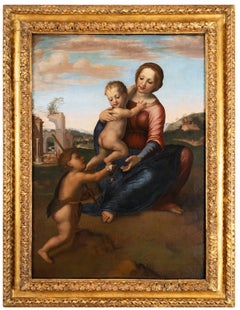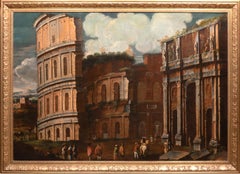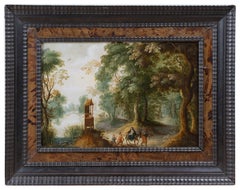Want more images or videos?
Request additional images or videos from the seller
1 of 13
Adam Frans van der MeulenLouis XIV and his army at the crossing of the Rhine by Adam-Frans van der Meulencirca 1680
circa 1680
$66,230.25List Price
About the Item
- Creator:Adam Frans van der Meulen (1632 - 1690)
- Creation Year:circa 1680
- Dimensions:Height: 57.09 in (145.01 cm)Width: 40.55 in (103 cm)
- Medium:
- Movement & Style:
- Period:1670-1679
- Condition:Very good original condition, cleaned and revarnished by our professionnal art restorer.
- Gallery Location:PARIS, FR
- Reference Number:1stDibs: LU2433214005172
About the Seller
No Reviews Yet
Vetted Professional Seller
Every seller passes strict standards for authenticity and reliability
1stDibs seller since 2023
17 sales on 1stDibs
Authenticity Guarantee
In the unlikely event there’s an issue with an item’s authenticity, contact us within 1 year for a full refund. DetailsMoney-Back Guarantee
If your item is not as described, is damaged in transit, or does not arrive, contact us within 7 days for a full refund. Details24-Hour Cancellation
You have a 24-hour grace period in which to reconsider your purchase, with no questions asked.Vetted Professional Sellers
Our world-class sellers must adhere to strict standards for service and quality, maintaining the integrity of our listings.Price-Match Guarantee
If you find that a seller listed the same item for a lower price elsewhere, we’ll match it.Trusted Global Delivery
Our best-in-class carrier network provides specialized shipping options worldwide, including custom delivery.You May Also Like
Early 1800's English Oil Painting Figure in Rural Woodland Landscape, original
By circle of John Constable
Located in Cirencester, Gloucestershire
Artist: English School, early 1800's, circle of John Constable (British 1776-1837)
Title: The Woodland Path
Medium: oil on canvas, framed, unsigned
Size: 12 x 22 inches
Picture: 9 x 18 inches
Provence: from a private collection in East Anglia...
Category
Early 19th Century Old Masters Landscape Paintings
Materials
Canvas, Oil
$4,668
H 12 in W 22 in D 1 in
HUGE 17thC ITALIAN OLD MASTER OIL PAINTING - KING & COURT FIGURES ROMAN BUILDING
Located in Cirencester, Gloucestershire
Artist/ School: Italian School, 17th century.
Title: A King and Queen before court figures, amidst a classical landscape with Roman columns.
Medium: oil painting on canvas, framed
...
Category
17th Century Old Masters Figurative Paintings
Materials
Canvas, Oil
$12,407
H 45 in W 60 in D 2 in
Antique Dutch Oil Painting Figures at Sunset by Coastal Estuary with Buildings
Located in Cirencester, Gloucestershire
A River Landscape With A Figure On A Donkey
1800's Dutch School
oil painting on canvas, framed
framed: 21 x 27 inches
canvas: 18 x 24 inches
provenance: private collection, England
...
Category
Early 19th Century Old Masters Landscape Paintings
Materials
Oil, Canvas
Huge 18th Century Italian Oil Painting Shipping in Merchant Port Many Figures
Located in Cirencester, Gloucestershire
The Merchants Port
Italian School, 18th century
oil painting on canvas, framed
framed: 37 x 58 inches
canvas: 32 x 52 inches
provenance: private collection, UK
condition: very good a...
Category
18th Century Old Masters Landscape Paintings
Materials
Oil, Canvas
Fishing at Dawn Old Trading Port with Many Figures Large Oil Painting
Located in Cirencester, Gloucestershire
Fishing at Dawn
English artist after an earlier work (see inscription verso)
signed oil painting on canvas, framed
inscribed verso
framed: 23 x 31 inches
canvas: 18 x 26inches
proven...
Category
Late 20th Century Old Masters Landscape Paintings
Materials
Canvas, Oil
$2,481
H 23 in W 31 in
Figures Chatting outside Village Tavern in Mountain Landscape, Period Oil
By 19th century Dutch or Flemish school
Located in Cirencester, Gloucestershire
Dutch/ Flemish School, early 1800's
oil on canvas, framed
framed: 19 x 24 inches
canvas: 13.5 x 18.5 inches
provenance: private collection, France
condition: good and sound condition...
Category
Early 19th Century Old Masters Landscape Paintings
Materials
Oil, Canvas
Large 18th Century English Old Master Oil Painting Portrait of Lady on canvas
Located in Cirencester, Gloucestershire
Portrait of a Lady
English School, 18th century
oil on canvas, unframed
canvas : 31 x 25 inches
provenance: private collection, UK
condition: good and sound condition
Category
Early 18th Century Old Masters Landscape Paintings
Materials
Oil, Canvas
Huge I1600's Italian Old Master Oil on Canvas Jesus at House of Mary & Martha
Located in Cirencester, Gloucestershire
Jesus at the House of Mary & Martha
Italian artist, 1600's
oil on canvas, unframed
Canvas: 32.5 x 56.5 inches
Provenance: Private collection, England
Condition: for a work of such mo...
Category
17th Century Old Masters Figurative Paintings
Materials
Oil, Canvas
Waterloo Battlefield with 3 Monuments - Butte du Lion, Antique Oil Painting
Located in Cirencester, Gloucestershire
The Battlefield of Waterloo
English School, 19th century
original oil painting on canvas, framed
canvas: 12 x 15.5 inches
framed: 17.5 x 20.5 inches
condition: overall very good and presentable, some former restoration and signs of retouching visible.
provenance: from a private collection
A very rare and historically important early painting, depicting the Waterloo battle...
Category
Early 19th Century Old Masters Landscape Paintings
Materials
Canvas, Oil
$6,065
H 17.5 in W 21 in D 2 in
Antique English Grand Tour Old Master Oil Figures Classical Arcadian Landscape
Located in Cirencester, Gloucestershire
Classical Landscape
English School, early 19th century, unsigned
oil on canvas, framed
framed: 29 x 37 inches
canvas : 19 x 27 inches
Provenance: private collection, UK
Condition: th...
Category
Early 19th Century Old Masters Landscape Paintings
Materials
Oil, Canvas
More From This Seller
View All17th century Italian school, The Virgin and Child with Saint John the Baptist
Located in PARIS, FR
17th century Italian School
The Virgin and Child with Saint John the Baptist
Oil on canvas
Dimensions: h. 106 cm, l. 77 cm
Important 17th century Italian carved giltwood frame
Fram...
Category
17th Century Old Masters Figurative Paintings
Materials
Canvas, Oil
A 17th c. Italian school, Capriccio with the Colosseum, circle of V. Codazzi
Located in PARIS, FR
A capriccio with the Colosseum in Roma
17th century Italian school
Circle of Viviano Codazzi (1604-1670)
Oil on canvas
Dimensions: h. 35.43 in, w. 51.18 in
Modern 17th century style ...
Category
17th Century Old Masters Landscape Paintings
Materials
Canvas, Oil
Flemish 17th c., Allegory of war and peace, circa 1630, by Adriaen van Stalbemt
Located in PARIS, FR
Adriaen van Stalbemt (Antwerp, 1580-1662)
Allegory of Peace and War, circa 1620-1630
Oil on oak panel: h. 49.5 cm, l. 73.2cm (19.29 x 28.74 in)
Giltwood ...
Category
Early 17th Century Old Masters Figurative Paintings
Materials
Oil, Panel
17th c. Flemish - Landscape with Flight to Egypt - Antwerp circa 1630
Located in PARIS, FR
LANDSCAPE WITH FLIGHT TO EGYPT,
JASPER VAN DER LANEN (ANTWERP, 1585 - 1634)
17TH CENTURY FLEMISH SCHOOL
ANTWERP CIRCA 1630
Oil on copper, dimensions: h. 10.23 in, w. 14.96 in
Flemish style frame in ebonized wood adorned with wavy moldings and wood veneer.
Framed dimensions: h. 17.32 in, w. 21.65 in
Provenance:
Philips auction...
Category
Early 17th Century Old Masters Figurative Paintings
Materials
Copper
$9,693 Sale Price
30% Off
Allegory of Summer, workshop of Hendrick Van Balen 17th c. Antwerp school
By Hendrick van Balen
Located in PARIS, FR
Allegory of summer, personified by Ceres
Workshop of Hendrick Van Balen
Antwerp School, early 17th century.
Oil on copper,
Dimensions: h. 52 cm, l. 40cm
Antic giltwood frame
Framed dimensions: h. 74 cm, l. 60cm
Very good condition
Our delicately painted work is part of the pictorial tradition that is both allegorical and mythological in vogue in Antwerp, whose leaders are Jan Brueghel the Younger and Hendrick Van Balen. Numerous works emerging from their workshops illustrate mythological subjects, the seasons, the elements, the senses or intertwining the lush landscapes, animals and gods of Olympus.
At the heart of a green landscape dominated in its center by a generous apple tree, the beautiful Ceres, partially dressed in a large blue drape, is wearing a crown of ears of wheat, her symbol of the goddess of the earth and harvests. She holds the sickle in her right hand and carries sheaves of wheat. To her right a nymph holds the cornucopia while puttis pick and offer flowers.
In the foreground are the summer fruits: figs, cherries, apples and lemons. A squirrel munching on cherries symbolizes toil and foresight, themes that are echoed in the work of the harvesters on the wheat fields in the background.
The background is composed of vegetation, on the right a wild rose bush with its branches erect against a tree trunk, in the center of the trees with silvery green foliage.
Our painter, a student of Hendrick Van Balen, finds his inspiration in the works of the master such as this nymph in yellow drapery seen from behind, one of the figures which accompanies many of the master's paintings. The elegant gestures, the flesh...The indisputable influence of Jan Brueghel the Younger is revealed in the treatment of trees and flowers, wild roses, tulips as well as in the still life with the squirrel in the foreground.
The craze for this type of virtuoso painting where the mythological figures are only a pretext to better illustrate the landscape and plant species surrounding them, then generated orders from all over Europe.
Hendrick Van Balen, Flemish painter, born and died in Antwerp (1575-1632). A student of Adam Van Noort, he entered the guild of Saint-Luc in 1593, later trained in Italy and was Van Dyck's first master. He often painted small characters taken from scenes from the Bible or classical mythology, on paintings in which Josse de Momper...
Category
Early 17th Century Old Masters Figurative Paintings
Materials
Copper
The Rape of Europa, signed Peter Sion (1624-1695), Antwerp, 17th century
Located in PARIS, FR
The Rape of Europa
By Peter Sion (Antwerp, 1624-1695)
Signed in the lower right corner P. Sion
17th century Antwerp School
Oil on copper, dim. h. 53 cm, w. 45 cm
Moulded and ebonized...
Category
17th Century Old Masters Figurative Paintings
Materials
Oak, Oil, Wood Panel
Recently Viewed
View AllMore Ways To Browse
French Sword
Rhine Art
Antique French Swords
Van Der Meulen
Vaux Le Vicomte
American West Paintings
Andrew Signed
B Boston
English Cottage Oil Painting
Fire Escape Used
Israel Landscape Painting
Lake Como Italy
New England Impressionist
New Hope Impressionist
Running Man
Suffolk Landscape
Western Impressionists
Windy Day


